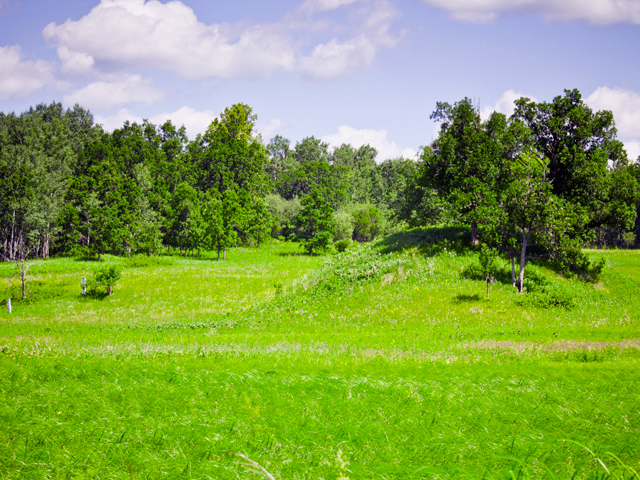This morning we visited the past at the Kay-Nah-Chi-Wah-Nung Historic Centre. Built on the banks of the Rainy River, the Ojibwe interpretive centre tells the story of the Place of the Long Rapids, where for thousands of years people lived and gathered. Also known as Manitou Mounds, this place — only 40 miles from the headwaters of the Mississippi — was at the centre of a continent-wide trading network for close to 8000 years. Traces of Ojibwe villages are found among the burial mounds and village sites of more ancient aboriginal peoples.
The burial mounds range in age from 300 to 8000 years old, and are spread along the banks of the river from the Rainy River First Nation to Rainy River. In more recent history, Ojibwe people would travel up the Rainy River to Lake of the Woods every year for the wild rice harvest. If there were any deaths during the important harvest, the bodies would be left on burial platforms along the river until the harvest was over, and then the bodies were collected and brought to the Place of the Long Rapids to be buried with ceremony.
The shoreline of the river in this area has been untouched by development, yet was a trading hub for people from all over North America. Seeds from far-away plants took hold, and now grow wild next to many of Ontario’s rarer plants in the native Oak Savannah Prairie. Sitting under a tree on the crest of a hill above the rapids, the scent of wild sage on the warm wind, it’s easy to imagine huge canoes filled with the rice harvest fighting their way up the busy water. There is something very special in the air here.
Nico, our guide, invites us to help rebuild a mound that was bulldozed before the area was under Ojibwe guardianship. Here, we walk counter-clockwise, back in time, to honour the spirits of the past. A handful of tobacco — in the left hand, it’s closest to the heart — is placed on the new mound, along with a handful of dirt from the old mound.
The Historic Centre also is home to a traditional roundhouse, which hosts frequent ceremonies. The interpretive centre itself, which opened in 1994, has beautiful displays of the history of the area, from the Archaic Culture through the Laurel and Blackduck and finally the contemporary Ojibwe people. There’s even a cozy little wigwam where I secretly had a lie-down after my close encounter with a gigantic piece of coconut cream pie in the aptly named Hungry Hall. We all feasted on wild rice casserole with fry bread and bannock, but I slyly stuck around after lunch for a chat with chef Lorraine and some dessert. Even without electricity, the meal was delicious.
The power came back on just in time for us to have a look around the lovely gift shop, which specializes in locally made Ojibwe arts and crafts.
We made our way to Caliper Lake provincial park, where we camped right on the water, and watched the sunset through the leafy green canopy above us.
Tomorrow — West we go!
Photo by Alexandra Sawicki












Speak Your Mind